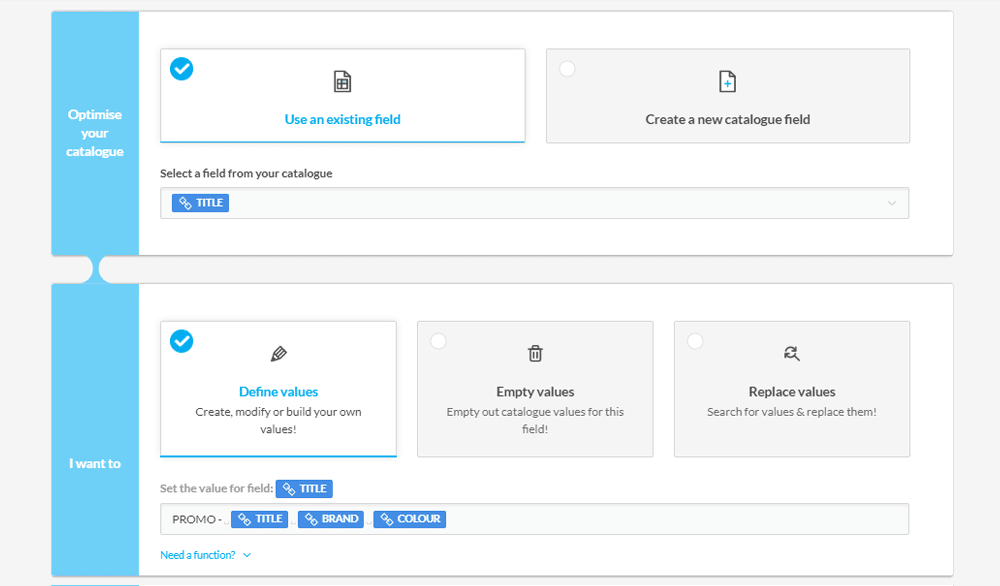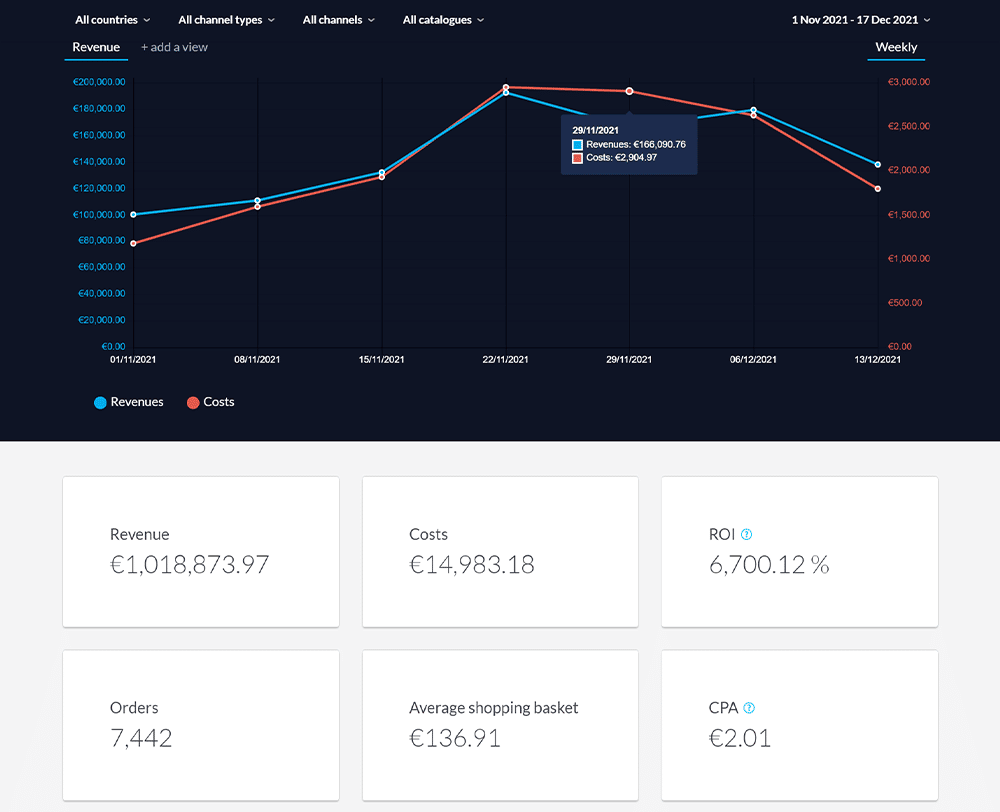8 Steps for a Successful Holiday Season on Marketplaces in 2023
07/09/23
11'
The last quarter of the year has always been crucial for brands and retailers, as major events like Black Friday or Cyber Monday shape this period. In 2022, marketplaces accounted for 56% of total global e-commerce sales*, so there is no doubt that the battle for customers’ attention will be fought mainly on marketplaces. As an e-commerce or marketplace manager, you should not underestimate the challenge of this battle and focus on an intelligent strategy on marketplaces.
With all brands competing for shoppers’ attention and buying fingers, and the end-of-year season beginning earlier and earlier each year (50 per cent of shoppers began their holiday shopping in 2021 before Black Friday), carefully planning this strategic period of the year is essential. However, optimising your content, defining your pricing strategy, and implementing your end-of-year marketing plan can be overwhelming, time-consuming, and labour-intensive.
Lengow can help you gain visibility on marketplaces during this critical period, saving time and driving growth while also providing insights into your results, KPIs and competitive environment. We’ve outlined eight steps that you must understand and implement to cut through the competitive noise on marketplaces. Follow our advice!
Summary
Step 1 – Plan your end-of-year strategy on marketplaces
Step 2 – Analyse historical data and prepare your product mix
Step 3 – Determine your pricing strategy to stay competitive
Step 4 – Optimise your product titles for search engines
Step 5 – Develop descriptions that help buyers make informed decisions
Step 7 – Ensure your logistics are as strong as possible
Step 8 – Analyse your results on marketplaces as you go and redefine your pricing if needed

Step 1 – Plan your end-of-year strategy on marketplaces
Black Friday, Cyber Monday, Ventes Privées, winter sales… the number of commercial events during the holiday season is significant. Organising and implementing them without a well-planned end-of-year strategy can be overwhelming.
- Decide which marketplaces you want to sell your products on as soon as possible. Being listed on a variety of marketplaces is always a good idea, because multi-category and niche marketplaces have different audiences and products for sale.
- Set a go-live date that’s at least a month before the start of the holiday season if you’re actively launching new marketplaces. This will enable you to resolve errors, ensure that your logistics are running smoothly, and conduct all necessary tests prior to peak season.
- Contact each marketplace’s account manager to obtain their deadlines. For instance, La Redoute requires your data two-three weeks before a sale, whereas Rue du Commerce and Rakuten need data only five days before.
How can we help?
- Lengow integrates with over 200 global or local marketplaces, multi-category and niche. Check out our Marketplace Finder to see with which marketplaces you could integrate to scale your business.
- You don’t want to miss out on holiday sales opportunities, but don’t have a team ready to carry out your end-of-year commercial activities? Our Operating team is here to assist you and can set up and operate your channels according to your campaign plans.

Step 2 – Analyse historical data and prepare your product mix
- Examine your top and bottom performers from the previous holiday season, as well as this year’s sales and current product priorities. This will help you in defining, for each marketplace, the best sellers, top SKUs, and low performers that you might want to boost with an additional discount.
- Ensure a diverse product mix. Don’t disappoint shoppers by selling only off-season or ‘old’ items; include brand new products too.
How can we help?
- Use our “Segments” feature to create product groups within your source catalogue according to a set of predefined criteria based on statistical data collected by Lengow (performance, profitability, seasonality, etc.). Before sending your catalogue to the marketplace, you can create specific rules for these segments, such as defining a specific level of discount you will apply to each product segment.


Step 3 – Determine your pricing strategy to stay competitive
In order to stay competitive in your market and, especially, on different marketplaces, you must define a clear and goal-oriented pricing strategy. But how do you know which one to develop?
- Carry out a solid competitive intelligence analysis to determine whether your current strategy on marketplaces is working as expected. The three primary measures to look at are: price index (level of competitiveness), margins (profits), and conversions (online orders).
- Implement a carefully evaluated pricing strategy to become more competitive than your competitors to increase revenue without jeopardising your profit margin. You might choose to implement one of the following strategies:
- Market penetration strategy: launching a product at a low price during the sales season and gradually raising it after that.
- Price discrimination strategy: changing the price of your products based on factors such as the time of purchase or the marketplace in which they are sold.
- Hi-Lo pricing strategy: during the holiday season, lowering the price of products that are outdated and have previously been sold for a higher price.
- Dynamic pricing strategy: choosing when and by how much to alter your rates relative to your competitors, using an automatic, dynamic pricing solution.
How can we help?
- Use a price intelligence solution such as Lengow’s Netrivals, to eliminate the extensive time and effort needed to conduct such a competitive analysis manually.
- Choose the dynamic pricing strategy if you want to stay competitive on marketplaces that change their prices frequently, such as Amazon. Netrivals, Lengow’s repricing solution, can ensure that even sudden changes are addressed by automatically changing your prices in accordance with your pre-defined rules.

Step 4 – Optimise your product titles for search engines
When selling during the holiday season, your first concern is to be found among the vast array of goods and products on marketplaces. A good product title piques viewers’ interest and entices them to click through. As a result, rich and optimised titles are critical. But what constitutes a good title, and how can you make it visible on marketplaces?
- Match the product title to potential buyers’ search results. Shoppers spend an average of 2-3 seconds scanning a product title. If it doesn’t meet their requirements, they will not investigate further.
- Place essential information at the start of your title, and include only the most important details. Remember: when shoppers search on their mobile phone, only the first 25-35 characters are displayed.
- Check the requirements of each marketplace to ensure you meet length, format, and other criteria. The fashion marketplace La Redoute, for example, requires each word in a title to begin with capital letters, and titles to avoid including the composition of products.
How can we help?
- Use our Optimisation rules to automatically improve your titles and apply them to all, or just a subset, of your products.
- Easily transform titles by including new text, concatenating multiple fields, and so on.
- Use the UPPERWORD function to create an automatic rule that adds a capital letter to all words in your title.


Step 5 – Develop descriptions that help buyers make informed decisions
The goal of product sheet enhancement is twofold: to increase organic traffic to your products through search result optimisation, and to provide shoppers with the information they need to make an educated decision. But where to start?
- Adjust product descriptions to reflect marketplace best practices and recommendations. A product description that works well for Amazon may not work as well on specialised marketplaces like Zalando or YOOX.
- Check that product sheets contain all relevant product information (brand, size, colour, composition, delivery date, origin, etc.). If your products fall short of expectations, you may face a higher return rate. Returns are inevitable, but good content can help soften the blow.
- Include as much rich content as you can. Videos, eye-catching images, diagrams, tables, and so on… Rich content helps by supplementing your product description and reassuring buyers.
How can we help?
- Use our Additional Sources to easily add ‘hot’ (stock information, prices, etc.) and ‘cold’ (pictures or videos) data to your product feed. Automatically update your various sources at any time to ensure that you always communicate up-to-date information.


Step 6 – Ensure your offers are active on your chosen marketplaces and monitor your marketplace metrics
Once pricing, product titles and product content are optimised, you need to ensure your offers are actively showing on the marketplace.
- Work on the marketplace integration errors ahead of the holiday season. Missed sale opportunities can be costly, so ensure all of your products are properly displayed on the marketplaces of your choice.
- If possible, submit requests to marketplaces’ support service before the holiday season. During peak sales season, response times may be significantly slower.
- During the holiday season, check your product feed several times a week to ensure everything is running smoothly and your products are still on sale. Marketplaces have strict KPIs for delivery time, customer service responsiveness, and negative reviews, and they have the authority to deactivate or suspend your account if you do not follow their rules.
How can we help?
- Find more information on how to include discounted prices and other sales information in your product feed in our Help Center. Our teams have worked on detailed ‘How to’ articles for all 200+ marketplaces integrated with Lengow, to assist you in preparing your product content.
- Check our Integration reports to understand where potential marketplace errors are coming from.

Step 7 – Ensure your logistics are as strong as possible
Poor customer service and long delivery times can ruin a brand’s reputation – especially during the holiday season when shopper expectations are highest. So, it’s critical to ensure that your logistics are as strong as possible.
- If you use fulfilment services from marketplaces (Amazon, Zalando, Cdiscount, ManoMano): make sure your stock arrives at the fulfilment centres on time, to ensure fast delivery during end-of-year season.
- If you manage the logistics yourself: make sure you have sufficient stock and contact suppliers to determine delivery times at the end of the year. You don’t want your orders to arrive after the holidays!
- If you’re using a hybrid fulfilment method: be sure to enter the correct delivery time based on your warehouse’s location.
- Use buffer stock and unpublish products with limited stock: if you sell products with low inventory on multiple marketplaces, you may oversell if several customers purchase the same product in a short period of time, and orders that you are unable to fulfil will be cancelled. This is bad practice for marketplaces, which may decide to deactivate your account.
- If the marketplace allows it, use the ‘restock date’ functionality: notify shoppers when your product will be back in stock. This can help them decide whether the wait is worthwhile or whether they should consider other options.
How can we help?
- While every marketplace has its own order system, Lengow centralises all your orders (from various marketplaces as well as your own website), saving you time by enabling you to view and control your orders in an automated and unified manner.
- Set up automatic distribution rules in Lengow to avoid delivery issues. Automatically exclude out-of-stock products and, thus, avoid overselling.

Step 8 – Analyse your results on marketplaces as you go and redefine your pricing if needed
As mentioned previously, it’s essential to monitor your competitor’s prices throughout the holiday season if you want your products to stand out from the competition. Since prices change all the time – and differently depending on the time of the day, the marketplace, and many other factors – you may need to adapt your pricing strategy several times during the holiday period to secure your competitive advantage.
How can we help?
- With a price monitoring solution like Netrivals (a Lengow company), filter the sellers you wish to include and exclude from your selected marketplaces, and implement a personalised pricing strategy.
- Easily deploy your preferred pricing strategies with our repricing solution, saving you time through automation.
- Easily track your KPIs with our reporting dashboards: orders, turnover, ROI, by marketplace, product, country or even category of products. These metrics are the key to optimising your distribution and adapting your end-of-year strategy.

Conclusion
Selling on marketplaces during the frantic period of every year that is Q4 requires proper planning and anticipation. It can take quite a lot of your (or your team’s) time and become overwhelming if you don’t have the right tools to automate manual tasks, optimise product content, and analyse data. Lengow both relieves you of this burden and, simultaneously, saves you time to allow you to focus on your e-commerce strategy.
With our dynamic pricing solution, you can also stay one step ahead of the competition on marketplaces during the sales period.
Contact us now to get started!
* 2022 Future of Marketplaces Report from Edge by Ascential
Your e-commerce library
E-commerce for Retailers
Learn moreE-commerce for Brands
Learn moreL'Oréal Luxe Success Story
Learn moreSign up for our newsletter
By submitting this form you authorize Lengow to process your data for the purpose of sending you Lengow newsletters . You have the right to access, rectify and delete this data, to oppose its processing, to limit its use, to render it portable and to define the guidelines relating to its fate in the event of death. You can exercise these rights at any time by writing to dpo@lengow.com

Trending Posts
Marketing channels
Where does Gen Z shop online?
Gen Z online shopping is transforming the digital marketplace, setting trends that redefine what it means to engage with brands…
16/04/24
9'
Marketplaces
The Top 10 Marketplaces in Europe
The e-commerce scene is a vibrant mix of marketplaces in Europe. These aren't just websites; they're bustling hubs where millions…
08/12/23
7'
Marketplaces
Lengow Now Fully Supports Zalando Logistics Solutions ZSS and ZRS
Zalando, one of Europe’s leading fashion marketplaces, continues to raise the bar with its advanced logistics and fulfillment programs. After…
12/12/24
4'
Marketplaces
How to win the Buy Box on Marketplaces (Amazon, Zalando, etc.)
What is the most important thing for marketplace sellers? Exactly, the Buy Box! If you don't have the Buy Box…
02/04/24
10'
Marketplaces
How to Sell on Temu? Best Tips
Emerging under the vast umbrella of PDD Holdings Inc., Temu has skyrocketed in popularity as a shopping sensation from China…
17/08/23
5'





